Orgyen Trinley Dorje
The Karmapa
Who is the Karmapa?
Source; www.kagyuoffice.org
The word Karmapa means "the one who carries out Buddha-activity"or "the embodiment of all the activities of the Buddhas."
In the Tibetan tradition, great enlightened teachers are said to be able to consciously arrange to be reborn as a teacher who can carry on the teachings of a predecessor in a prior life. Pursuant to this tradition, the Karmapas have incarnated in this form of manifestation body (Skt. nirmanakaya), for seventeen lifetimes, as of the present, and all have played an important role in preserving and propagating the Buddhist teachings.
Prophecies and Predictions about The Karmapa
Prior to the birth of the first Karmapa, the arrival of a Buddhist master who would be known as the Karmapa was prophesied by the historic Buddha Shakyamuni and the great Tantric master of India, Guru Padmasambhava.
|
|
Samadhiraja (King of
Samadhi
)
Sutra: Two thousand years after my passing, The teachings will spread in the land of the red-faced ones, Who will be the disciples of Avalokita: The bodhisattva Simhanada, known as Karmapa, will appear. Possessing mastery over samadhi, he will tame beings And establish them in bliss through seeing, hearing, recalling and touching. |
|
|
From the Lankavatara (Manifesting in Lanka) Sutra : |
Wearing monastic robes and a black crown,
He will perform unceasing benefit for beings
Until the teachings of one thousand buddhas disappear.
|
|
|
From the Mulamañjushri (Root of Mañjushri) Tantra: Endowed with a name beginning with Ka and ending with Ma, There will appear an individual who illuminates the teachings. |
Throughout the centuries, Karmapas have been the central figure in the continuation of the Vajrayana lineage in general and Kagyu lineage in particular, and have played a very important role in the preservation of Buddhism.
The current Karmapa, His Holiness the 17th Karmapa Orgyen Trinley Dorjee is 24 years old and resides in Dharamsala India.

[
On November 5
th 1981, H.H. the Sixteenth Karmapa passed away at
the American International Clinic in Zion, near Chicago, Illinois,
USA. His
Holiness' kudung (body) was flown back to India. Karmapa's cremation ceremony
took place in Rumtek monastery. Indian dignitaries and several thousand of his
disciples from all over the world attended the services.
On June 26 th 1985 the seventeenth reincarnation of the Karmapa was born in the Lhatok region of eastern Tibet.
In 1992 this Tibetan nomad child, named Apo Gaga (Happy Brother), was officially recognized and brought to his monastery, Tolung Tsurphu Monastery in Central Tibet, where he was enthroned on September 27- with the permission of the Chinese government.
At Tsurphu, the Karmapa studied the Buddhist sciences of mind, learned ritual, and practiced sacred arts, such as dance. Each day he received hundreds of visitors from throughout Tibet and around the world. He eventually began to offer empowerments and participated in various rituals at the monastery.
As the years went by, however, His Holiness sought to receive the empowerments and transmissions of the Kagyu lineage, but was unable to do so fully because many of the Kagyu lineage teachers remained in India. To fulfill his spiritual duty, he and a handful of attendants left Tibet for India.
After months of careful planning, on December 28, the fourteen-year-old Karmapa pretended to enter into a solitary retreat, instead donned civilian garb, and slipped out a window. Leaving Tsurphu Monastery with a handful of attendants, he began a daring journey by car, foot, horseback, helicopter, train and taxi, a heroic journey which was to become headlines throughout the world.
January 5, 2000 he arrived in Dharamsala India, where he was met by His Holiness the fourteenth Dalai Lama and given a temporary living arrangement in the Dalai Lama's Gyuto temple 14 kilometers from Dharamsala.
The Karmapa received refugee status from the government of India in 2001.
From 2000 to present, His Holiness has continued to live in Dharamsala, at the
Gyuto Ramoche University monastic compound which has been deemed,
"The Karmapa Camp –temporary residence of His Holiness the Karmapa".
Source Kagyu Office website www.kagyuoffice.org
On June 26 th 1985 the seventeenth reincarnation of the Karmapa was born in the Lhatok region of eastern Tibet.
In 1992 this Tibetan nomad child, named Apo Gaga (Happy Brother), was officially recognized and brought to his monastery, Tolung Tsurphu Monastery in Central Tibet, where he was enthroned on September 27- with the permission of the Chinese government.
At Tsurphu, the Karmapa studied the Buddhist sciences of mind, learned ritual, and practiced sacred arts, such as dance. Each day he received hundreds of visitors from throughout Tibet and around the world. He eventually began to offer empowerments and participated in various rituals at the monastery.
As the years went by, however, His Holiness sought to receive the empowerments and transmissions of the Kagyu lineage, but was unable to do so fully because many of the Kagyu lineage teachers remained in India. To fulfill his spiritual duty, he and a handful of attendants left Tibet for India.
After months of careful planning, on December 28, the fourteen-year-old Karmapa pretended to enter into a solitary retreat, instead donned civilian garb, and slipped out a window. Leaving Tsurphu Monastery with a handful of attendants, he began a daring journey by car, foot, horseback, helicopter, train and taxi, a heroic journey which was to become headlines throughout the world.
January 5, 2000 he arrived in Dharamsala India, where he was met by His Holiness the fourteenth Dalai Lama and given a temporary living arrangement in the Dalai Lama's Gyuto temple 14 kilometers from Dharamsala.
The Karmapa received refugee status from the government of India in 2001.
From 2000 to present, His Holiness has continued to live in Dharamsala, at the
Gyuto Ramoche University monastic compound which has been deemed,
"The Karmapa Camp –temporary residence of His Holiness the Karmapa".
Source Kagyu Office website www.kagyuoffice.org
A Brief Account of Recent History
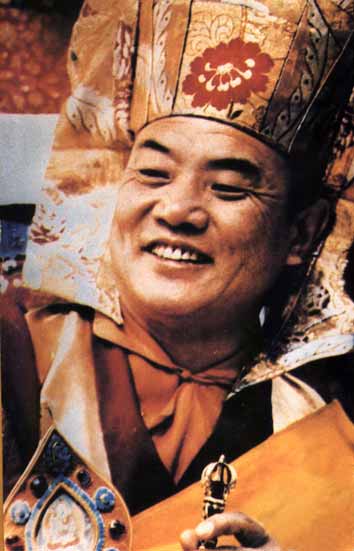




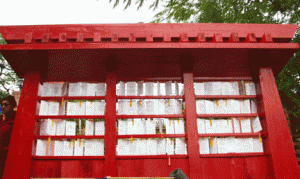




"Ah World"
World, we live and die on your lap. On you we experience all our woes and joys. You are our ancestral home of old. Forever we cherish and adore you.
We wish to transform you into the pure realm of our dreams. We wish to transform you into a land for all creatures, Equal for all and free of prejudice. We wish to transform you into a loving, warm, and gentle goddess.
Our hope in you is so ever resolute. So please be the ground on which we all may live So all these wishes may come true, So all these wishes may come true. Do not show us the dark side of your character, Where nature's calamities reign.
In every section of our world's land May there thrive a fertile field of peace and joy, Rich with the leaves and fruits of happiness, Filled with the many sweet scents of freedom. May we fulfill our countless and boundless wishes.
His Holiness the 17th Karmapa composed this doha (spiritual song or praises) in October 2005
World, we live and die on your lap. On you we experience all our woes and joys. You are our ancestral home of old. Forever we cherish and adore you.
We wish to transform you into the pure realm of our dreams. We wish to transform you into a land for all creatures, Equal for all and free of prejudice. We wish to transform you into a loving, warm, and gentle goddess.
Our hope in you is so ever resolute. So please be the ground on which we all may live So all these wishes may come true, So all these wishes may come true. Do not show us the dark side of your character, Where nature's calamities reign.
In every section of our world's land May there thrive a fertile field of peace and joy, Rich with the leaves and fruits of happiness, Filled with the many sweet scents of freedom. May we fulfill our countless and boundless wishes.
His Holiness the 17th Karmapa composed this doha (spiritual song or praises) in October 2005

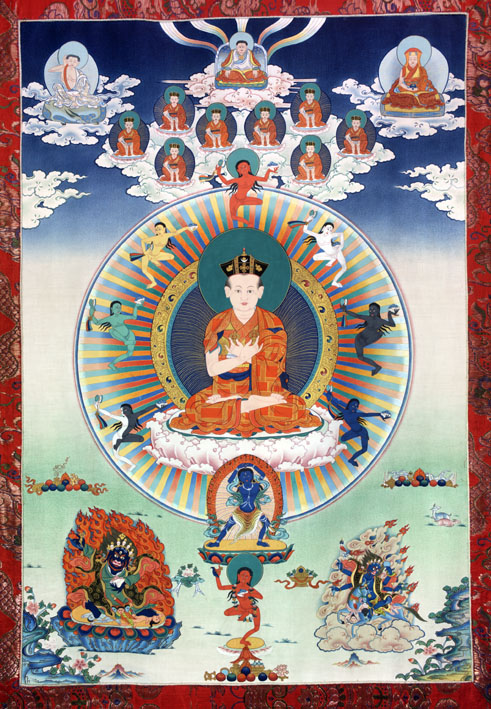
In May 2008, His Holiness was finally granted permission to travel outside of India. He visited America for a short two weeks, offering teachings in several dharma centers and large venues in three major American cities. Since then, He has expressed his wish to return but has not received permission to leave India.
Go to Karmapa News for updates and activities.
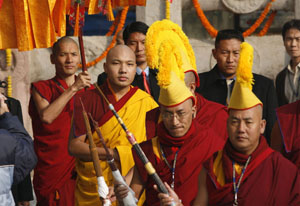
Karmapa, embodiment of the compassion of all the Buddhas
Karmapa, union of the awakened activity of all the Buddhas
Karmapa, empowered as regent of all the Buddhas
Orgyen Drodul Trinley, may your life be long…(and happy.)
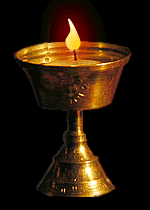
His Holiness The 17th Gyalwang Karmapa - Orgyen Trinley Dorje -


Current Activities of the Karmapa
See the Karmapa's official Kagyu Monlam site for more information
www.kagyumonlam.org
www.kagyumonlam.org
Gyalwang Karmapa’s Play of The Life of Milarepa Performed in Bodhgaya, January 2010
http://www.kagyumonlam.org/English/News/Report/Report_20100101_1.html

26TH INTERNATIONAL KAGYU MONLAM NEWS RELEASE
www.kagyumonlam.org
Source Kagyu Monlam website
BODHGAYA 4TH – 11TH JANUARY 2009
The International Kagyu Monlam is an eight day Buddhist prayer festival held annually in Bodhgaya, the place of Buddha's enlightenment. His Holiness the 17th Gyalwang Karmapa Ogyen Trinley Dorje, head of the Karma Kagyu School of Tibetan Buddhism, presides over the festival, supported by many leading Rinpoches from the Kagyu tradition, including H.E. Jamgon Kongtrul Rinpoche, H.E. Goshir Gyaltsab Rinpoche, Ven. Zurmang Garwang Rinpoche, Ven. Kalu Rinpoche, Ven. Khenchen Thrangu Rinpoche and Ven. Mingyur Rinpoche.
In the words of His Holiness:
"Kagyu Monlam is an avenue whereby we can spread, at times of great need, the genuine spirit of love and compassion to all the people of the world, like a great ripple, first in Bodhgaya, then in Bihar, and so on. As we continuously offer these prayers for world peace, it is our intention and our wish that peace and happiness extend to all.
This year's Monlam has several special features which reflect His Holiness' concern to develop peace, harmony and understanding between different peoples and religions, making it a truly international festival. ""
His Holiness's Activities:
THE MONLAM PRAYER BOOK IN EIGHT LANGUAGES
This has now been translated from the original Tibetan and published in Hindi, Chinese, English, French, German, Korean and Spanish.
A MANDALA CONTAINING STONES FROM 101 COUNTRIES
A specially constructed mandala shaped altar, with Mt. Meru at the centre, has been filled with pebbles from all five continents of the world and 101 different countries, symbolizing the earth and all her peoples. Bringing the pebbles together symbolizes bringing together their minds and wishes. The collection also includes two meteorites. There will be a special blessing ceremony to bring peace and happiness and well-being to all corners of the globe. The mandala will then be dismantled , the stones packed into special individual boxes, and the boxes distributed to foreigners attending the Monlam, who will take them back to their countries. So the stones will once more be dispersed to all five continents, carrying the blessings with them.
THE MAIN ENTRANCE GATE
This year's entrance gate is constructed from wood and covered in coloured cloth. The five colours of the cloth – white, green, yellow, blue and red - are known as the "wisdom' colours. Each represents one of the five Buddha families. Suspended from the gate are banners of the mantra: Om Pemo Uni Kha Bema Le Hung Phat. This mantra has powers of purification so that all who pass through the gate during the Monlam festival will receive some spiritual benefit.
ASPIRATION PRAYER BANNERS
These have been hung along the stone palisade near the back gate. They show aspirations from all over the world: in Tibetan, Chinese, English, French, German, Spanish and Korean. His Holiness' intention is to raise awareness of how people of different cultures have different concerns, hopes and aspirations.
ASPIRATION PRAYER GATE
The rear entrance to the Monlam enclosure is through a Japanese style red Tori gate, hung with aspiration prayers from around the world, in different languages.
BUTTER SCULPTURES REPRESENTING ALL TRADITIONS OF TIBETAN BUDDHISM
The butter sculptures on the right show the great Kagyu founders, Marpa, Milarepa and Gampopa, but this year the ones on the left show the great masters of other Tibetan Buddhist lineages – the Nyingmapa, Sakyapa and Gadenpa (Geluk) traditions. This symbolizes the essential unity of Tibetan Buddhism and the interrelationship between the different schools.
TEACHINGS FOR EAST AND WEST
The growing international importance of Kagyu Monlam is highlighted by the inclusion of more Buddhist teachings this year. Last year Gyalwang Karmapa gave teachings to foreigners only over three evenings. This year he has extended his teaching schedule. Before the Monlam, His Holiness accepted a request from the Taiwanese Hwa-Yue Foundation to give three days of teaching on Teachings of the Lineage Masters. More than 1500 people attended these teachings. After the Prayer Festival His Holiness will give a further three days of teaching, entitled Living the Dharma, this time to a predominantly Western audience. More than 1500 people are expected to attend.
FOOD OFFERINGS FROM EIGHT COUNTRIES
The tsog this year comes from different countries: a cane sugar, milk and nut sweet from India; potato chips from the USA; milk toffees from Germany; croissant from France; ginseng tea from Korea; tsampa from Tibet; mochi rice cake from Taiwan; dried fruit and nuts from Spain. Ten thousand special bags of tsog have been prepared for distribution at the end of the Monlam.
THE GYALWA KARMAPA'S SPECIAL ADDRESS TO THE KAGYU MONLAM
January 11, 2009, Translated by Karma Choephel
Link for Environmental Guidelines
…In particular, I have produced a book of guidelines for environmental protection that will be distributed to all the monasteries once the Tibetan translation has been completed. It has been finished in English and Chinese, and there are plans to produce it in other languages as well. Once this is done, all the monasteries, dharma centers, associations and individuals in the different countries of the world should motivate themselves to do something about this situation that is threatening the world. There is no better Dharma practice than doing something good for all the beings who live and depend on this world. From a worldly perspective as well, this is a critical life-and-death situation. Please keep this in mind. This is my first point.
See His Holiness Karmapas environmental website www.khoryug.com
Finally, today we are bringing the 26th Kagyu Monlam to a successful conclusion, so we should dedicate the virtue we have created during it. We should make the aspiration that this virtue become the seed of peace and happiness for all the limitless beings throughout space, and that it become a cause that increases and gives power to our love and affection. In particular, we should keep in mind those beings to whom we are directly connected, the beings who live on this planet, and dedicate the virtue we have done to them. We should make the vast aspiration that they may receive this just as we have dedicated it.
GYALWA KARMAPA'S TEACHINGS "LIVING THE DHARMA" Jan 14 2009
January 14, 2009, Tergar Monastery, Bodhgaya India
The first question concerned the profound meaning of reciting "Karmapa Khyeno'. His Holiness began his answer by explaining the meaning of "karma': activity, or action, and "pa': one who performs that activity.
He told how 100,000 Dakinis wove the black hat from their hair, consecrated it, and offered it to the first Karmapa, Dusum Khyenpa. He was the one who performed all the activities of the Buddhas and Bodhisattvas of the three times and ten directions. His Holiness also said that it does not need to be one particular individual who is called "Karmapa', but that it can be a general name for all Vajra Masters who do the activities of the Buddha. It can be regarded as a title for all genuine masters. The Buddha had prophesied that when the Dharma is nearing extinction, he would come in the form of Vajra Masters to perform his Buddha activity.
His Holiness said that as we think primarily for the benefit of all suffering sentient beings, we also have to think about the container for sentient beings – this world in which all the sentient beings live. It has the capacity to provide all the necessities for sentient beings. We must be aware of the environment, and know about the destruction of the environment. He described how the forests are being destroyed in very terrible ways without any compassion or understanding, and how with wrong understanding, we were ignorant of what to get rid of and what to keep. We must know what we need to do for the benefit of others.
If we give rise to the aspiration to work for others, that is good, but we need more than that. We need to complete that aspiration by making a commitment to work for sentient beings. We should train and act in the Six Paramitas. This is what is meant by action, so we must do that according to our level, and according to the strength of our minds.



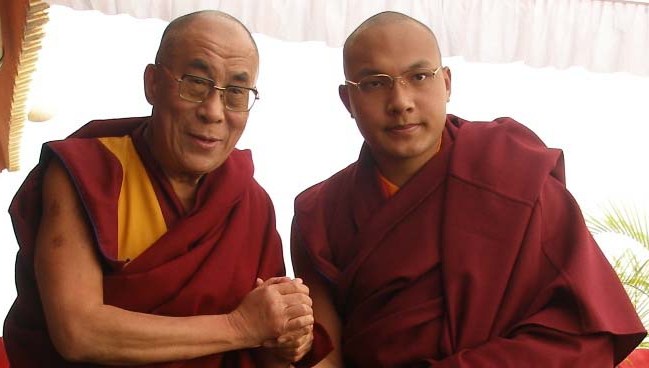



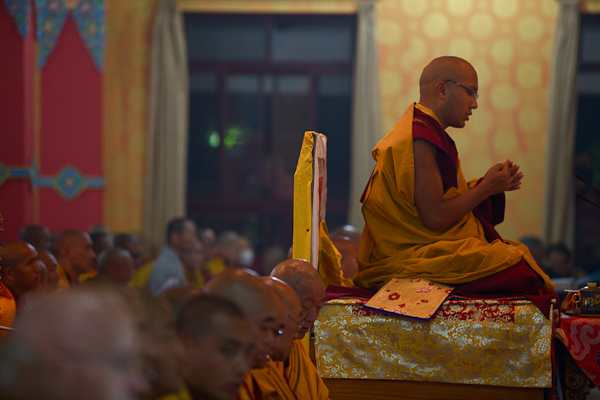

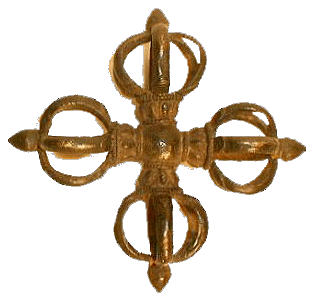
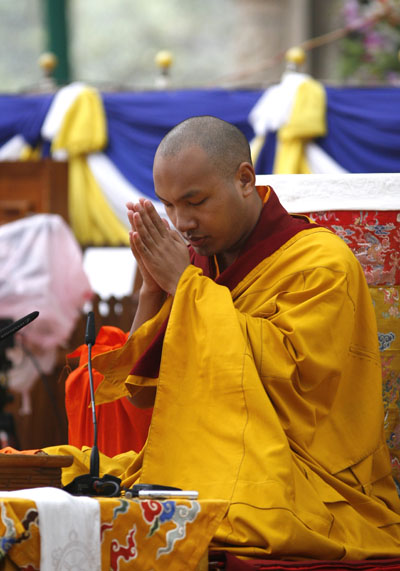
Tibetan Thanka; Second Karmapa- 12th century

